The Supersizers Go...Elizabethan
The erstwhile food time travellers went back to the earliest era covered in the Supersizers Go series, the Elizabethan period, which would be the equivalent of the Renaissance in the rest of Europe. It was a great time in British history, with adventurers exploring the world and bringing goods back from the New World, and the arts thriving, especially in the form of the Great Bard William Shakespeare.
It was also a quite exuberant and uninhibited society, one of the reasons why it's one of my favorite periods in history. Here you see Sue Perkins contemplating Giles Coren's massive codpiece with amusement.
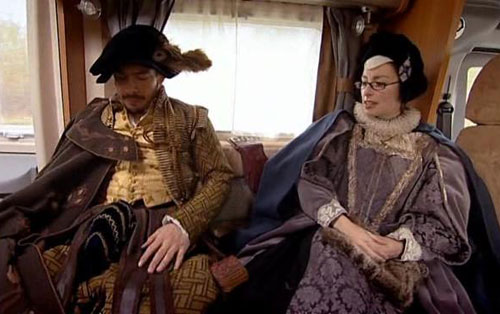
(She later stroked it, but I will spare you that scene.)
Incidentally, I did complain earlier about the fact that the BBC has been showing the episodes out of chronological sequence (World War II, Restoration, Victorian, 1970s, Elizabethan, Regency). At the start of the episodes Giles says in voiceover that they will be exploring food in history 'over the next few weeks', so it's fairly clear that they intended to show it in sequence. I can see the logic of why they mixed it up instead though, because it could have gotten a bit monotonous. Until fairly recent times, well-off people in Britain ate more or less the same way: lots and lots and lots of meat, with the occasional vegetable, livened up by whatever new and exotic food had come into fashion through discovery and trade. So there isn't that much difference between the way the people at in the 14th through the 19th centuries, or even beyond that, until people started to really rely on pre-made and/or pre-packaged foods.
Anyway, here's the obligatory Gross-out Cooked Animal Head - in this case, a sheep's head with Pertenance, or all the entrails.
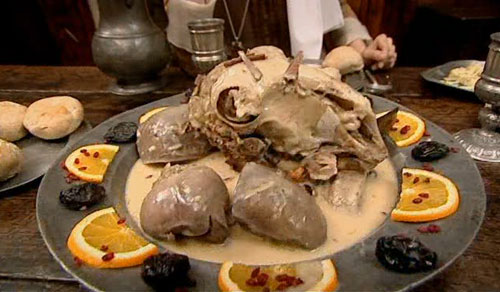
Most of the meals in this episode were prepared by Paul Merrett, who is one of my favorite on-TV chefs who hosts a semi-educational series called Ever Wondered About Food. (He deserves to be as well known as Jamie Oliver or Gordon Ramsay--he's just as articulate and photogenic as both of them. Maybe it will still happen.)
The Elizabethans believed in 'head to tail' eating, not wasting any part of the animal. This is something us modern squeamish and wasteful eaters could learn from. (If you think about it, the French and the Chinese, creators of two of the most reknowned cuisines, still eat a lot o the animal, like tripe and sweetbreads.)
Tea and coffee were still unknown, so Sue and Giles missed them terribly (Sue was almost hallucinating about tea bags). People drank beer since water was undrinkable, and rich people had wine at dinner. Hippocras was a sweet mulled wine that was popular to drink near the end of a meal.
The Elizabethans loved pretty foods, like this sallet (salad) with lots of flowers. I have experimented a bit with edible flowers (nasturtiums are nice and peppery), but you really have to grow your own. I wouldn't mind seeing this come back into fashion.
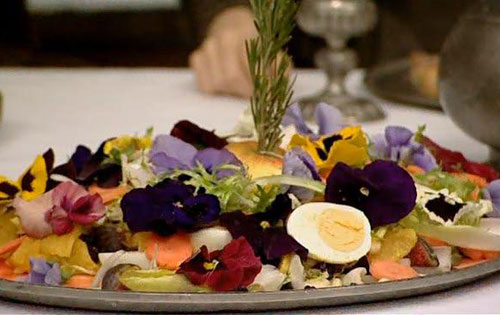
They also liked visual puns and being a bit dirty. These are milk jellies (rather like junket or blancmange I guess) called Spanish paps; 'pap' can mean the Pope, or breasts.
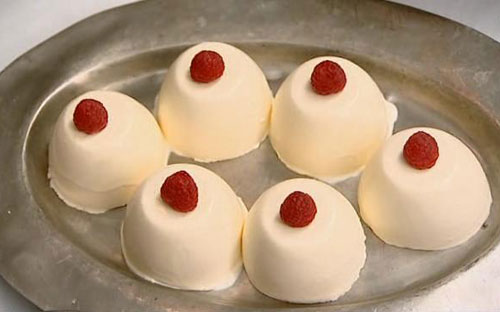
It's interesting to note that jellified food used to be considered a delicacy until quite recently, maybe up until the molded jelly salads of the '70s and '80s (see Let's Gourmets). This is probably because gelatin used to be very time consuming to produce. Nowadays of course, people almost sneer at jelly and vegetarians vilify it. I do still enjoy a fruit jelly sometimes myself.
Back to the Elizabethans. Much of life was relagated by religious and royal command. People were allowed to only eat fish on Wednesdays, Fridays and Saturdays--this was expanding on the religious reasons for eating fish on Fridays, and was purely pragmatic. The Royal Navy, which needed to keep active to protect merchants ships going back and forth to the New World, harass the Spanish and so on, also doubled as a fishing fleet, and they needed to be kept afloat.
One key ingredient merchant ships brought back in bigger quantities was sugar. It was still a luxury item, so the rich tried to use it as much as possible. Queen Elizabeth liked sugary sweets so much that her teeth turned black. This was turned into a fashion, so all ladies blackened their teeth and whitened their faces, following the example of their Queen.
Here is a selection of suckets, or dried sugared fruits. These were eaten with marchpane, a kind of marzipan (they didn't bring it up in the show, but marzipan was often gilded with gold leaf for a banquet).
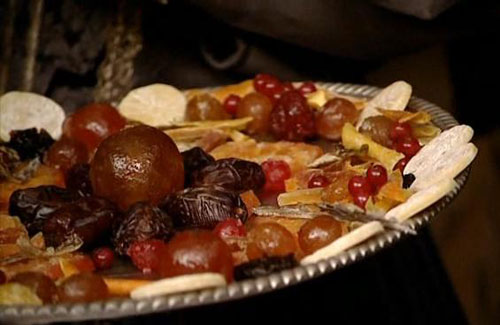
So after a week of heavy meat eating with plenty of fat and sugar, how did Giles and Sue fare health wise? Sue lost 4 kilo, and Giles lost 3 kilo and lowered his cholesterol.Sue was even told to regain the weight since she was now underweight. It's like the Atkins Diet...but with sugar! The body is an odd thing.
Other fun facts
- Elizabethans ate with a knife and their fingers, and had a napkin draped around one shoulder. They would wipe their greasy fingers on the napkin. This sounds much more practical than draping a napkin on your lap. My food always gets stuck on something else before it can get to my lap (mostly my chest)!
- When Queen Elizabeth went touring around the country, she and her entourage would stay at the houses of her wealthier subjects. They required so much feeding that watering that a visit could ruin the host financially.
- Bread was eaten with every meal. The whiter it was, the more desirable and more expensive. (White bread was the desirable type until quite recently really.)
- Wealthy people were regularly 'cupped' to draw out blood with bad humors. Apparently, wealthy people of today do this too, like Gwyneth Paltrow.
- The Queen issued 382 proclamations during her reign, and more than 200 of those were related to food.
Food from the past in Provence
It may just be because I love Provence so much, but as I was watching this episode it struck me that you can still get a lot of the sweets that the Elizabethans (and before them, people of the Middle Ages) loved in that region. Sugared fruits, which to me look just like the suckets they showed, are still a Provençal speciality. Calissons, a speciality of Aix-en-Provence, are rather like marzipan flavored with melon. Nougat, which is a speciality of the town of Montélimar, is a very old fashioned sweet if you think about it. (If you make it to Provence and are driving down from the north, do stop in Montélimar for some nougat - it's unbelievably good!)
There's a French confectionery store chain called La Cure Gourmande with stores all over France which sells these things too. Here are couple of displays I took photos of at some La Cure stores in Provence. The sugared fruits are very pretty, but I must say that most of them are way, way too sweet for me. I feel like my teeth are going to fall off when I eat them. No wonder Queen Elizabeth lost most of hers.
A list of the foods and recipes mentioned in this episode
Breakfast
- Cold meat pie
- Manchet bread
- Small beer
Dinner (taken between 11AM and 2PM)
1st course:
- Pumpkin pie (pumpkins came from thew new American territories in Virginia)
- Meat Pottage (a soup of boiled meat and oatmeal, the Queen's favorite)
- Stewed Mutton Steaks
- Manchet Bread
- Small beer
2nd course:
- Capons with Damsons (capon boiled with mace, raisins, currants, prunes)
- Calf's Foot Jelly (made by boiling calf's feet, flavored with sherry, cinnamon, ginger, rosewater)
- Custard (a custard pie)
Tavern fayre (Giles does a little gambling )
- Oysters
- Peascods (a veggie burger made of figs, raisins and flour)
- Hazelnuts
- Big Beer
Supper
1st course:
- Meat Custard
- Lambs Head with Purtenance (lamb's head with all the innards boiled together)
- Manchet Bread
- Small Beer
2nd course:
- Boiled Pigeons
- Calf's Lungs
- Buttered Posset
- Suckets (candied fruit, used to sweeten the breath)
- Hippocras
Food on a sea voyage (actually a tourist boat on the Thames, but never mind)
- Clotted cream
- Dried hardtack
- Pig's fat (used as sunblock)
- Pickled oysters
- Shredded beef preserved with large grains of salt called corns--or in other words, corned beef
- Ham preserved in honey or salt
Shakespearean dinner
Derived from the great bard's works
- Mackerel
- Herring
- Salad
- Tripe
- Cheese and Pippins (apples)
- Stewed Prunes (which were overcharged for by prostitutes at brothels)
- Small Beer
Gentleman's Hunting Dinner
- Roast Venison with Furmenty (a mixture of wheat, cream, eggs and sugar)
- Claret
Commoner's Dinner
- Big Beer
- Umble Pie (humble pie; pie made of chopped up innards of deer)
Dinner Party
Preparations:
- Sue makes up her face with ceruse, which was made of white lead and vinegar, and blackens her teeth
1st course:
- Hodge Podge (based on the Dutch Huetspot, a mixture of meats cooked together in great quantity)
- Sallet with flowers
- Claret
2nd course:
- Turkey with Galantine Sauce (turkey imported from the New World, a luxury item; served with a prune and blood sauce)
- Chicken and Egg Fricassée
- Warden Pie (spiced pear pie)
- Spanish Paps (looking sort of like perky breasts)
Banquet course:
- Marchpane (a sort of marzipan)
- Dry Suckets
- Quince Jelly
- Medlar Fruit
- Red and black currants
- Curd Cheese (eaten at the end of the meal, believed to close the stomach to help digest the meal)
- Hippocras
Fish Day Breakfast
- Cod and Sprats
- Butter with Sage
- Manchet Bread
- White Wine
Fish Day Dinner in Greenwich
1st course:
- Fish jelly
- Carp with a Pudding in its Belly
- Boyled Pike with Oranges
- Lemon Sallet
- Claret
2nd course:
- Spitchcocked Eels (panfried eel)
- Tart of Pickled Fish (with figs, dates and cream)
- Almond Custard (made with almond milk and bits of fish)
- Suckets
Falstaff's Tavern Dinner
Based on a receipt found in his pocket
s = shillings, d = pence
- A Capon 2s 2d
- Sauce 4d
- Sack 2 gallons 5s 8d
- Anchovies and Sack after supper 2s 6d (chicken and anchovies cooked together)
- Bread 1/2d
Cookshop Supper (Elizabethan fast food)
- Whole Spit Roast Capon
Breakfast on the road (Queen's grand tour around the country)
- Beef Pottage
- Meat Pie
- Small Beer
Feast at a country house (for the Queen and her entourage)
1st Course:
- Whole Pygge (roast suckling pig)
- Boyled Beef
- Deer-Shaped Loaf (a large deer's head shaped pie with innards that bleed claret)
- Goose with Sorrel Sauce
- Grand Sallet
- Manchet Bread
- Claret
2nd Course:
- Rabbits with Puddings in Their Bellies
- Battalia Pie (filled with 'small blessed objects', mostly animal parts like lamb's testicles and oysters)
- Venison Pasties
- Dish of Snow
- Surprise Pie (a pie crust filled with live frogs for the guests' amusement)
- More Claret
Banquet Course:
- Flowers made of sugar
- Dry Suckets
- Fruits
- Curd Cheese
- Hippocras
- Aqua Vitae
Links and references
- A recipe for manchet bread
- Renaissance candy recipes
- A cookery book they used as a reference, "The Accomplisht Cook or the Art and Mystery of Cookery" by Robert May, is available in various online formats on Project Gutenberg
Supersizers Go recaps
- Edwardian Supersize Me, not part of the series, but sort of the pilot that aired in 2007
- Description of the whole series, plus World War II (episode 1)
- Restoration (episode 2)
- Victorian (episode 3)
- 1970s (episode 4)
- Elizabethan (episode 5)
- Regency (episode 6, last in series)
If you enjoyed this article, please consider becoming my patron via Patreon. ^_^


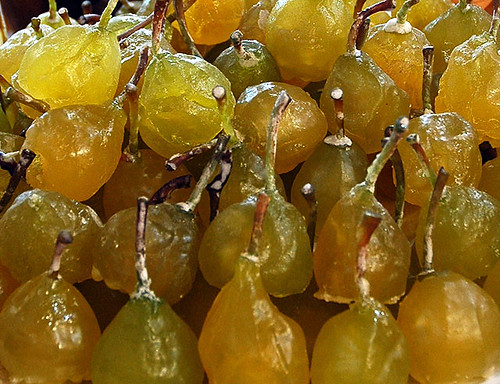
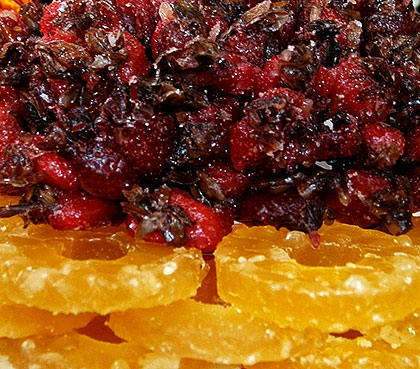

 Welcome to Just Hungry, where we serve authentic Japanese recipes and more! I'm
Welcome to Just Hungry, where we serve authentic Japanese recipes and more! I'm 












Comments
rosa
22 June, 2008 - 02:54
Permalink
Hey, This show seems
Hey,
This show seems interesting!! Love the recaps.
Do you have any idea of a recipe for the milk jellies? They look like they could be good... haha.
maki
22 June, 2008 - 08:04
Permalink
spanish pap
This page quotes some recipes from old cookbooks. It sounds a lot like blancmange flavored with rosewater and spices though (the last link has modern precise measurements).
Cilean
8 March, 2011 - 03:29
Permalink
Re: spanish pap actual historical recipe
I am in the SCA (www.SCA.org) in which we recreate the foods of the past, however in order to do this? I need a real recipe that I can redact, where it was found in what book and where I can actually find it!!
I would love to make this for a Court, but I need!!!! The recipe!!
So if anyone knows where the chef found the recipe please let me know!!
Cilean
Lily
20 August, 2008 - 21:22
Permalink
Great recap
I was rerouted here from a Slate article. What a great recap and history lesson. By the way, I'm a fan of your bento site.
anon.
21 December, 2009 - 07:02
Permalink
Re: The Supersizers Go...Elizabethan
I loved the show. Watched it on You Tube and now it is pulled-off. Does anyone have a copy of the show or know how I can get a copy?? I even went to BBC site to find a copy with no luck.
I am in a Renaissance re-creation group, the SCA (Society for Creative Anachronism)www.sca.org, and my time period is 1540's.
Glad to see the menu of the show listed. Thanks.
anon.
6 August, 2010 - 03:46
Permalink
Re: The Supersizers Go...Elizabethan
this site has the menu, but where can i find the recipes? theres a few that i want
SixDegrees
20 February, 2012 - 00:11
Permalink
Re: The Supersizers Go...Elizabethan
Nice to see this series resurrected on The Food Channel, and a shame that it is so short. I would love to see more episodes, perhaps branching out to examine cuisines from different periods in different countries.
It would also be nice if the recipes served were available somewhere.
anon.
4 April, 2013 - 18:06
Permalink
Re: The Supersizers Go...Elizabethan
I'd love to get a copy of this video for a class I am teaching. My class is in the fall of 2013. Will it be available on DVD or can I still get it on YouTube?
maki
4 April, 2013 - 20:08
Permalink
Re: The Supersizers Go...Elizabethan
I'm totally the wrong person to ask. I wrote this review years ago when the program was shown on BBC, but otherwise I have no connection at all to the producers or the BBC. As far as I know there are no DVDs out of the series. You may want to try contacting the BBC. Good luck!
vosche
24 January, 2016 - 20:18
Permalink
royalty and the poor
what an inventive way to make sure subjects and lords never owned more wealth than the queen..go out among wealthy lords and make them feel compelled to feed you and your horde and show all of you such a good time that was so expensive they end up financially ruined! brilliant!!